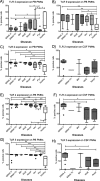Toll-like receptors 4 and 9 are responsible for the maintenance of the inflammatory reaction in canine steroid-responsive meningitis-arteritis, a large animal model for neutrophilic meningitis
- PMID: 23016675
- PMCID: PMC3488568
- DOI: 10.1186/1742-2094-9-226
Toll-like receptors 4 and 9 are responsible for the maintenance of the inflammatory reaction in canine steroid-responsive meningitis-arteritis, a large animal model for neutrophilic meningitis
Abstract
Background: Steroid-responsive meningitis-arteritis (SRMA) is a systemic inflammatory disease affecting young adult dogs and a potential large animal model for neutrophilic meningitis. Similarities between SRMA and infectious central nervous system (CNS) diseases in lymphocyte subsets suggest an infectious origin.Toll-like receptors (TLRs) are pattern recognition receptors playing an important role in innate immunity. Due to their ability to recognize both self and non-self antigens, we hypothesize that TLRs are among the key factors for the induction of the inflammatory process in SRMA and provide an indirect hint on the etiology of the disease.
Methods: The expression profile of cell surface TLRs (TLR2, TLR4 and TLR5) and intracellular TLRs (TLR3 and TLR9) of canine leukocytes was analyzed by immunophenotyping and subsequent flow cytometric measurements. Experiments were performed on cerebrospinal fluid (CSF) and peripheral blood (PB) samples of dogs affected with SRMA during the acute phase (n = 14) as well as during treatment (n = 23) and compared with those of dogs with bacterial meningitis (n = 3), meningoencephalitis of unknown etiology (n = 6), neoplasia of the central nervous system (n = 6) and a group of dogs with miscellaneous neurological diseases (n = 9). Two additional control groups consisted of dogs with pyogenic infections (n = 13) and of healthy dogs (n = 6).
Results: All examined groups showed a high percentage of TLR2, TLR4 and TLR5 positive PB polymorphonuclear cells (PMNs) in comparison to healthy dogs. Very high values of TLR9 positive PB PMNs were detected in acute SRMA. Only a few similarities were found between SRMA patients and dogs with pyogenic infections, both groups were characterized by high expression of TLR4 positive PB monocytes. Glucocorticosteroid therapy reduced TLR2, TLR4 and TLR9 expression in PB monocytes.
Conclusions: A relatively high expression of TLR4 and TLR9 in acute SRMA suggests that these two receptors might be involved in the inflammatory process in SRMA, enhancing the autoimmune reaction. Systematic CSF cell analysis for TLRs can be performed in future treatment studies in larger animals, such as dogs.
Figures




Similar articles
-
Selective CD11a upregulation on neutrophils in the acute phase of steroid-responsive meningitis-arteritis in dogs.Vet Immunol Immunopathol. 2008 Dec 15;126(3-4):248-55. doi: 10.1016/j.vetimm.2008.07.007. Epub 2008 Jul 29. Vet Immunol Immunopathol. 2008. PMID: 18760844
-
Th17-skewed immune response and cluster of differentiation 40 ligand expression in canine steroid-responsive meningitis-arteritis, a large animal model for neutrophilic meningitis.J Neuroinflammation. 2017 Jan 23;14(1):20. doi: 10.1186/s12974-016-0784-3. J Neuroinflammation. 2017. PMID: 28114998 Free PMC article.
-
The endocannabinoid system in canine Steroid-Responsive Meningitis-Arteritis and Intraspinal Spirocercosis.PLoS One. 2018 Feb 6;13(2):e0187197. doi: 10.1371/journal.pone.0187197. eCollection 2018. PLoS One. 2018. PMID: 29408878 Free PMC article.
-
An update on steroid responsive meningitis-arteritis.J Small Anim Pract. 2010 Mar;51(3):150-4. doi: 10.1111/j.1748-5827.2009.00848.x. Epub 2010 Jan 11. J Small Anim Pract. 2010. PMID: 20070497 Review.
-
Biomarkers of non-infectious inflammatory CNS diseases in dogs: Where are we now? Part 2 - Steroid responsive meningitis-arteritis.Vet J. 2021 Jul;273:105692. doi: 10.1016/j.tvjl.2021.105692. Epub 2021 May 6. Vet J. 2021. PMID: 34148607 Review.
Cited by
-
Acute meningitis in rats is associated with decreased levels of miR132 and miR146a.Cent Eur J Immunol. 2014;39(3):316-22. doi: 10.5114/ceji.2014.45941. Epub 2014 Oct 14. Cent Eur J Immunol. 2014. PMID: 26155141 Free PMC article.
-
Of potential new treatment targets and polythetic approach in meningoencephalitis of unknown origin: a review.Front Vet Sci. 2024 Oct 15;11:1465689. doi: 10.3389/fvets.2024.1465689. eCollection 2024. Front Vet Sci. 2024. PMID: 39474275 Free PMC article. Review.
-
Magnetic resonance imaging findings in dogs with steroid-responsive meningitis-arteritis in the UK and their clinical significance: 53 cases (2013-2021).J Small Anim Pract. 2025 Jan;66(1):33-42. doi: 10.1111/jsap.13775. Epub 2024 Sep 4. J Small Anim Pract. 2025. PMID: 39228252 Free PMC article.
-
Peripheral white blood cell patterns in children with hydrocephalus as a response to ventriculo-peritoneal shunt infection.PLoS One. 2024 Aug 9;19(8):e0308131. doi: 10.1371/journal.pone.0308131. eCollection 2024. PLoS One. 2024. PMID: 39121090 Free PMC article.
-
Neutrophil extracellular traps in CSF and serum of dogs with steroid-responsive meningitis-arteritis.PLoS One. 2024 Jan 19;19(1):e0295268. doi: 10.1371/journal.pone.0295268. eCollection 2024. PLoS One. 2024. PMID: 38241272 Free PMC article.
References
-
- Tipold A, Moore P, Zurbriggen A, Vandevelde M. Lymphocyte subset distribution in steroid responsive meningitis-arteriitis in comparison to different canine encephalitides. Zentralbl Veterinarmed A. 1999;46:75–85. - PubMed
-
- Tipold A, Somberg R, Felsburg P. [Is there a superantigen effect on steroid-responsive meningitis-arteritis in dogs?] Tierarztl Prax. 1996;24:514–518. - PubMed
-
- Burns JC, Felsburg PJ, Wilson H, Rosen FS, Glickman LT. Canine pain syndrome is a model for the study of Kawasaki disease. Perspect Biol Med. 1991;35:68–73. - PubMed
MeSH terms
Substances
LinkOut - more resources
Full Text Sources
Medical

